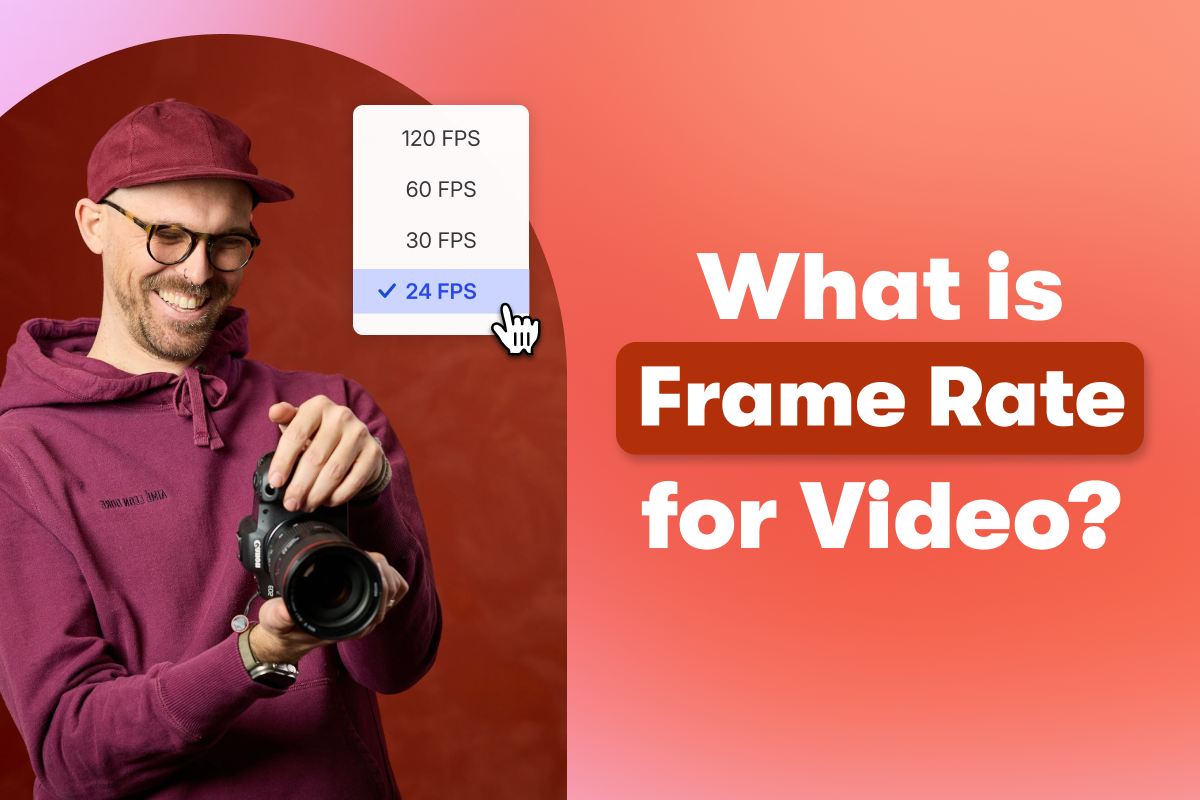What Is a Video Frame Rate?
Find out more about frame rates and how to pick the best one for your shot.
July 16, 2025
Topic tags

A frame rate is the number of images your camera captures every second while recording. It’s measured in frames per second (fps). For example, a frame rate of 24 fps means the camera records 24 images per second.
The most common frame rates
The best frame rate for video is… whichever one fits the job! Different frame rates create different looks. Let’s talk about the most common ones in video.
24 fps: Cinematic standard
Today’s movies and TV shows are shot in 24 fps. It’s because this frame rate creates an artistic look with just the right amount of motion blur that our brains have come to associate with “movie magic.”
This standard goes all the way back to the early days of film. It was the lowest frame rate that could sync with sound while keeping film costs down. It stuck around because it gives video a dreamlike quality that tells the viewer that they’re watching a story, not reality.
30 fps: Video standard
This is the go-to frame rate for live TV, news broadcasts, sports, and soap operas — all formats that aim to reflect real life. It offers a slightly smoother motion than 24 fps, which makes motion look more lifelike. That balance between realism and performance is one reason why many smartphones default to 30 fps.
60 fps and higher: Slow-motion standard
If you’re after ultra-smooth footage or planning to slow things down in post-production, this frame rate (or higher) is a solid choice. It gives your video a sharp, lifelike feel that’s great for capturing fast action.
Slow motion is where higher frame rates shine. When you shoot in 120 fps or 240 fps, you get the extra frames you need to slow down your footage without making it look choppy. The more frames you capture, the more you can play around with the speed. This is how you can get a dramatic shot of a water droplet or a balloon popping in perfect detail.
Does higher fps mean higher quality?
Nope. More frames per second doesn’t mean higher video resolution or better image quality. It just gives you smoother motion, which is especially useful for action or slow-motion shots. When played at normal speed, it can create a hyper-real “soap opera look,” which is something you may want to avoid for cinematic projects.
2 ways to specify the frame rate
1. Non-drop frame
In this method, the frame rate is specified as a whole number like 30 fps or 60 fps. This means each second of video is made up of exactly that many frames, and the frames are displayed at a consistent rate.
2. Drop-frame
In this method, the frame rate is specified as a fraction, such as 29.97 fps or 59.94 fps. This means that the actual rate at which frames are displayed is slightly lower than the specified rate, and some frames are “dropped” to maintain a consistent rate in situations where the frame rate may fluctuate a bit. This helps make the video appear smooth and natural to viewers.
This method is typically used for footage that’s broadcast over television because the frame rate must be synchronized with the broadcast signal.
How to change the frame rate
On a camera
On most mirrorless or DSLR cameras, you can adjust the frame rate usually within the first few pages of the main menu.
You’ll often see options like 24 fps, 30 fps, or 60 fps, along with settings that affect compression and file size. Depending on the camera brand, these may be labeled differently (such as IPB, ALL-I, or XAVC), but in general, higher compression means smaller file sizes and lower image quality, while lower compression means higher quality footage and larger file sizes.
When in doubt, check your camera’s manual or look up your model online to see how it best handles frame rate and compression combinations.
On a smartphone
By default, your iPhone’s video recordings are set to 30 fps. You can adjust your iPhone frame rate in the Record Video subsection of the camera settings menu.
- Go to the Settings app
- Scroll down to Camera
- Go to Record Video
- Choose the frame rate you want for your iPhone videos
Matching frame rates in post-production
Choosing the right frame rate doesn’t end when you hit record. It’s just as important during editing. Matching your project’s frame rate to your footage keeps motion smooth, prevents playback issues, and helps your final video look clean and consistent.
How to set the frame rate in Premiere Pro
- Check your footage’s frame rate. Right-click it in the Project panel and select Properties.
- Create a sequence that matches your footage. Drag the clip onto the New Item icon, or go to File > New > Sequence and choose the correct frame rate in the Settings tab.
- Right-click the sequence, select Sequence Settings, and adjust the Timebase if needed.
Working with mixed frame rates
If your project includes footage shot at different frame rates, it’s usually best to edit it in the lower frame rate (like 24 fps or 30 fps) to maintain a consistent cinematic or natural look.
Editing in a higher frame rate can work too, but it may make lower frame rate footage appear choppy or out of place. To combat this, most editing software offer tools that help smooth out footage when you’re mixing different frame rates. Often called frame blending or optical flow, these features can fill in missing frames to make everything look more natural.






